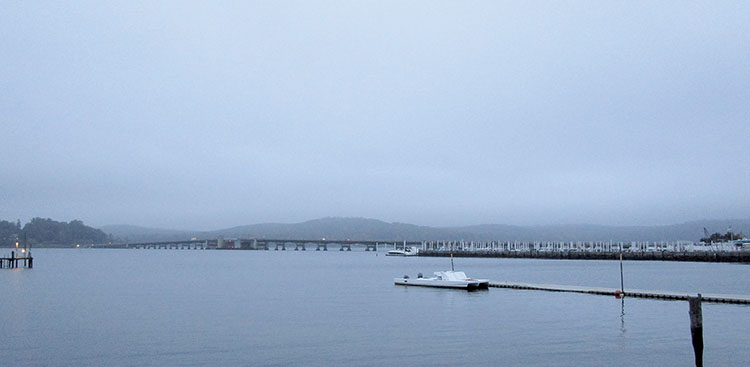Story and photos by Joseph Sapia
Since the Rally for the Navesink meetings started in late June, much of the talk has been about tracking down and rectifying sources of the river’s suspected pollution.
That is, human, domestic animal, farm animal and wildlife waste; fertilizers and pesticides; and petroleum products.
Basically, it is an issue of nonpoint source pollution, or storm water carrying a blend of this individually small pollution to the river, where it forms a stew of greater pollution. Over the last decade or so, the river has deteriorated with high fecal bacteria counts and depleted oxygen levels.
But at the fourth Rally for the Navesink meeting – held Thursday, Oct. 20, at Knollwood School in Fair Haven – its pro-environment organizers brought a hands-on approach for regular citizens to stop pollution in the river’s 95-square-mile watershed. They laid out specific ideas on how to stop pollution in the first place – planting native plants, creating environmentally friendly yards, making rain gardens, developing “living shorelines” and using less pavement.
“Everybody can play a little part,” said Amanda Brockwell, deputy executive director of the Monmouth Conservation Foundation (MCF).
Hopefully, people will hear of ways to protect the river that resonates with them, she said.
Native plants, for example, need little or no fertilizers or pesticides, said Karen Waltzer, public outreach coordinator for the Barnegat Bay Partnership. She suggested searching the Jersey-Friendly Yards website, jerseyyards.org, to determine suitable native or friendly-to-the-environment plants for specific conditions.
Becky Laboy, education and outreach specialist for the state Ocean Soil Conservation District, talked about “8 Steps to a Jersey-Friendly Landscape” on the jerseyyards.org site: plan plantings, create healthy soil, wisely water, fertilize less, use safer methods to control pests, reduce the size of not-so-eco-friendly lawns, create a wildlife habitat and recycle in the yard.
“Land-use and individual choices affect everything in the Navesink,” said Zach Lees, the ocean and coastal policy attorney for the Sandy Hook-based Clean Ocean Action (COA) environmental group, which has been the lead organization running the rally.
In natural areas, only 10 percent of rainwater rolls away, with the other 90 percent being absorbed, said Christopher C. Obropta of the Rutgers University Cooperative Extension. In an area such as Red Bank, 55 percent of rainwater runs off.

This runoff can be controlled by such things as rain gardens, specially planted areas that absorb water, along with filtering it, and permeable pavement, Obropta said.
There are an estimated 200,000 people living in the watershed – “Everybody has a stake in that water,” said William D. Kastning, executive director of the MCF.
In welcoming the approximately 60 attending the meeting, Cindy Zipf, COA’s executive director, and Kastning talked about the state of the Navesink River.
“Our favorite river is affected in bad ways,” Kastning said. “It looks good, but it is in trouble.”
Earlier this year, for example, the state Department of Environmental Protection extended its shellfishing ban on the river another 500 acres or so downstream to the Oceanic Bridge connecting Rumson and Middletown.
“I firmly believe we’re going to be able to work on that downgrade and get that water quality back,” Zipf said.
Do not do anything and “it’ll get worse,” Kastning said.
For those living along water, they could try “living shorelines,” creating natural plant areas as an alternative to, say, bulkheading to control erosion.
“Living shorelines are a better alternative to deal with shoreline erosion than hard structures,” said Zack Royle, habitat restoration coordinator for the Sandy Hook-based American Littoral Society environmental group.
Habitat is lost with hard structures because there is no softening water dispersal as with vegetation, Royle said. Living shorelines are part of the environment, self-maintaining, aesthetically pleasing and have an unlimited lifespan.
People with yards also can help the environment by using fewer chemicals and less water, said Steve Tuorto, director of science for the Stony Brook-Millstone Watershed Association.
The next and last meeting of the year for Rally for the Navesink is scheduled for Nov. 30. The time and location will be announced.














